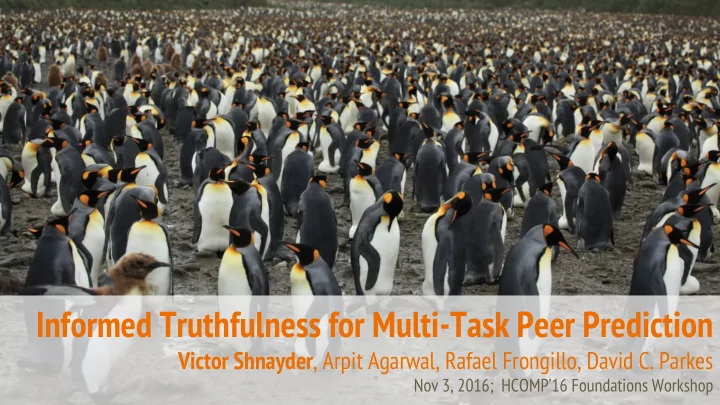

Informed Truthfulness for Multi-Task Peer Prediction Victor Shnayder , Arpit Agarwal, Rafael Frongillo, David C. Parkes Nov 3, 2016; HCOMP’16 Foundations Workshop 1
Let’s talk about crowdsourcing 2
Task: How many cows in this image? 3
Count: 23 4
… or just guess: 42 5
Get feedback: “23 is good. $0.02” 6
Get feedback: “42 is way off! $0.00” 7
Get feedback: “42 is way off! $0.00” Where did feedback come from? 8
Get feedback: “42 is way off! $0.00” Where did feedback come from? Gold standard: professional cow counter said 23 9
Get feedback: “42 is way off! $0.00” Where did feedback come from? Machine vision: automated cow counter said 20-25 10
Get feedback: “42 is way off! $0.00” Where did feedback come from? Peers: 3 others said 20, 22, 24 11
Peer prediction: giving feedback based on peer reports 12
“1 cow” “good!” Observe “1 cow” Evaluate “good!” Observe “ 7 cows ” “bad!” Observe 13
Applications beyond s Gather location-specific info Image and video labeling Search result evaluation Academic peer review Participatory sensing Evaluations for peer assessment in massive courses 14
Goals: Ensure truthful equilibrium exists and is attractive Impossibility results 15
Task model i Task Agent 1 Signal: 1 … n 16
Task model i Task Agent 1 Prior probability P(i) 17
Task model i j Task Agent 1 Agent 2 Joint probability: P(i,j) 18
Task model i j Task Agent 1 Agent 2 People can misreport! 19
Task model i j Task Agent 1 Agent 2 Goal: design scores to encourage effort, truthful reports 20
Output agreement (von Ahn, Dabbish ‘04) Agree! Score 1 1 1 Task Agent 1 Agent 2 21
Output agreement Don’t agree: score 0 1 2 Task Agent 1 Agent 2 22
Output agreement Task Agent 1 Agent 2 Honest reporting is a correlated equil if my signal predicts yours 23
Output agreement Task Agent 1 Agent 2 To manipulate: all agents always report same thing 24
Ensuring truthful reporting is best [Kamble et. al. ’15, Radanovic et. al. ’16] Agree! Score 1/(scaling factor) 1 1 Task Agent 1 Agent 2 Scaling factor learned from reports on many similar tasks. Truthfulness is an equilibrium, guarantees highest payoff. 25
Multi-task approach Task 1 [Dasgupta-Ghosh’13] 1 1 Task 2 Agent 1 26
Multi-task approach Task 1 [Dasgupta-Ghosh’13] 1 1 2 Task 2 Agent 1 Agent 2 2 Task 3 27
Key idea Task 1 1 Likely to match 1 2 Task 2 Agent 1 Agent 2 2 Task 3 28
Key idea Task 1 1 L e s s l i m k e a l t y c h t o 1 2 Task 2 Agent 1 Agent 2 2 Task 3 29
Key idea Task 1 1 1 2 Task 2 Agent 1 Agent 2 2 Task 3 Reward matching on shared tasks. Punish matching on non-shared tasks. 30
Why doesn’t this Just Work with >2 signals? Task 1 1 1 2 Task 2 Agent 1 Agent 2 2 P(agree on shared) – P(agree on non-shared) Task 3 31
Our multi-signal mechanism: Correlated Agreement 1. Split tasks into shared and non-shared. 2. Score = (agree on shared) – (agree on non-shared) “Agree” when reports aren’t equal, but positively correlated. Constant or random reporting still has expected score 0 32
The Correlated Agreement mechanism 1. Informed truthful —being truthful is optimal, better than constant or random reports 2. Works with minimal information with few tasks 3. Works with no information with many tasks 33
Connection to information theory Truthful score ~ D TV (P( ⋅ , ⋅ ) - P( ⋅ )P( ⋅ )) More agreement ⇒ higher scores. Other rules correspond to different distance functions. [Kong-Schoenebeck ‘16] 34
Open questions Is peer prediction practical as primary incentive? When? Combine peer prediction with other incentive models in a single system? Heterogeneous agents Non-binary effort models Non-random task assignment (e.g. maps) Unintended correlated “signals” 35
Thank you! shnayder@post.harvard.edu 36
Extra slides 37
Setup Agents 1, 2, tasks k Signals i,j (require effort) Shared tasks, agent 1 tasks, agent 2 tasks Signal prior P(i), joint P(i,j) Strategies: F, G probability of reporting r given signal i. Informed strategy: depend on the signal somehow Truthful strategy: F * 38
Solution concepts E(F, G): expected payment for a shared task (Strict) Proper: E(F * , G * ) ≥ E(F, G * ), for all F != F * Strong-truthful: E(F * , G * ) ≥ E(F, G), for all F, G (if expected payment tied, F and G must be permutations) Informed-truthful: E(F * , G * ) ≥ E(F, G), for all F, G (if expected payment tied, F and G must be informed) 39
A useful matrix 40
Example Delta Prior: Joint: Delta: Sign(Delta): 41
Scoring matrix 42
Expected payment (Lemma: can restrict to deterministic strategies) 43
Key theorem The Correlated Agreement mechanism is informed truthful for all * models. 44
Proof sketch 45
Other results Detail-free version of mechanism: learn scoring matrix from reports Correlated Agreement is maximal among large class of mechanisms that use this scoring structure Much simpler analysis of Dasgupta-Ghosh’13 mechanism 46
Binary mechanism (Dasgupta-Ghosh ’13): 1. Split tasks into shared and non-shared. 2. Score: (agree on shared) – (agree on non-shared) Expected score: P(agree on shared) – P(agree on non-shared) Have to agree based on properties of shared task. Constant or random reporting has expected score = 0 47
Recommend
More recommend